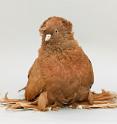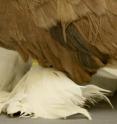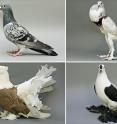Pigeon foot feather genes identified
Related images
(click to enlarge)
University of Utah scientists identified two genes that make some pigeon breeds develop feathered feet known as muffs, while others have scaled feet. The same or similar genes might explain scaled feet in chickens and other birds, and provide insight into how some dinosaurs got feathers before they evolved into birds. The study found that in pigeons with feathers on their hindlimbs or feet, a hindlimb-development gene named Pitx1 is less active than normal, while a forelimb-development gene named Tbx5 is active in the feet, where it normally is not.
In other words, "pigeons' fancy feathered feet are partially wings," says biologist Mike Shapiro, senior author of the study published today by the journal eLife.
In mutant pigeons with foot feathers, "the hindlimb is clearly recognizable as a leg, but it has taken on more forelimb characteristics," he says. "It's not a complete transformation of a leg into a wing. Rather, components of the leg are more winglike, including feathers and a larger leg bone."
Shapiro and colleagues found that the Pitx1 and Tbx5 genes themselves are no different in breeds with and without foot muffs. Instead, they learned that nongene "regulatory sequences" of DNA near the genes act like switches to turn down the activity of hindlimb gene Pitx1 and turn up activity of forelimb gene Tbx5 in the embryos of pigeons with foot feathers.
"Our experiments show that these switches work differently in birds with feathered feet relative to the ones with normal, scaled feet," Shapiro says.
The two genes were previously known in all vertebrate animals, and they are linked to limb and other defects in people. The new study showed how they "provide a mechanism by which scaled and feathered skin regions can be controlled," Shapiro says.
Of pigeons, dinosaurs and early birds
Most birds have scales on the feet and toes and feathers elsewhere. Some -- like snowy owls, golden eagles and ptarmigans -- have foot feathers. Only chickens and domestic pigeons -- with 146 and over 350 breeds, respectively -- have breeds with and without foot feathers in a single species.
"A major change that occurred in the evolution of birds from dinosaurs was the replacement of scales by feathers throughout the body," Shapiro says. "Pigeons give us an unusual chance to understand the genetic and developmental mechanisms that might control this change because there are pigeon breeds with and without foot feathers."
Some dinosaurs had foot feathers, which may have been common in meat-eating theropods, including raptors and Tyrannosaurus rex.
"We don't know if Pitx1 and Tbx5 were specifically involved in feather-footed dinosaurs, but this gives us a genetic and developmental mechanism that could have done it," he adds. "We have no direct way of knowing how that change occurred in dinosaurs. However, we see a lot of striking anatomical similarities between dinosaurs' feathered legs and feet and pigeons with feathered legs and feet. So pigeons might give us some insights into how the skin knows to develop scales or feathers."
"Based on what we found in pigeons, the change from scales to feathers can be genetically very simple," he says. "This can give us some clues about not only how pigeons get feathered feet, but perhaps about how ancient birds lost foot feathers."
The new study was funded by the National Science Foundation, Burroughs Wellcome Fund and the National Institutes of Health.
Shapiro performed the study with University of Utah postdoctoral researcher Eric Domyan; human genetics doctoral student Zev Kronenberg; biology graduate students Anna Vickrey, Rebecca Bruders and Sydney Stringham; undergraduate student Michael Guernsey; and human genetics professors Gabrielle Kardon and Mark Yandell. Other co-authors were at the University of Georgia.
Genes that help define wings and legs
"The genes we found that control feathered feet determine forelimb versus hindlimb identity," Shapiro says, and were already known for other functions besides their newfound role in foot feather development:
"Tbx5 is critical for proper forelimb development in all vertebrates -- fish [fins], chickens, mice and even humans," he adds. "Mutations in the gene in humans cause Holt-Oram Syndrome, which results in arm defects and heart defects in newborns."
"Pitx1 has been known for a long time to be critical for hindlimb development in vertebrates," including people, Shapiro says. "If Pitx1 is inactivated, mice get severe hindlimb defects. The bones change size and shape. They also get severe brain and jaw defects. Mutations in Pitx1 in humans can lead to clubfoot" and Liebenberg syndrome, which causes elbow and wrist defects that make the arms more leglike.
Shapiro and colleagues showed that to get feathers on pigeons' hindlimbs or legs, the normal hindlimb signal from Pitx1 goes down, making the leg less like a hindlimb, and the forelimb signal from Tbx5 goes up, making the leg more like a wing.
"In pigeons when Tbx5 is expressed in the leg, the leg takes on some forelimb or wingike characteristics, including feathers," he says. "In some breeds with feathered feet, the fibula or outer shin bone becomes much bigger" and more like a bone in the wing.
Finding foot-feathering genes
Shapiro and coworkers did breeding experiments in which they crossed muffed pigeons named Pomeranian pouters with scale-footed pigeons known as Scandaroons. Then they crossed the offspring.
"In the grandkids, some birds had scaled feet, others had big muffs and others were in between, with a range of scales and feathers," he says. "They usually had both. This told us very few genes were involved in this trait, as we expected." (If most of the birds were intermediate, that would indicate many genes were involved.)
"Then we looked for associations between DNA sequences and the amount of feathering on the feet in the grandkids," Shapiro says. "We found that only two regions in the genome had significant associations with foot feathering."
"When the grandkids inherited versions of those stretches of DNA that came from the feathered grandparent, then they had more and bigger feathers," he adds. "When they inherited the stretches of DNA from the scaled grandparent, then they had fewer and smaller feathers. That told us these two places in the genome had a huge effect on feather versus scale development in the feet."
Next, "we compared the entire genome sequences of 15 feather-footed breeds with the genomes of 28 scale-footed breeds," Shapiro says. "We found the same two places in the genome differed between the scale-footed and feather-footed breeds. This also identified smaller regions of the genome as being the locations of the genes."
The researchers then tested how genes in those regions were expressed or activated in pigeon embryos, allowing them to identify Pitx1 and Tbx5 as the genes switching foot feather development on or off.
They confirmed that with other experiments looking at how each gene was activated in pigeon embryos from crosses between scale-footed old Dutch capuchin pigeons and fairy swallow pigeons with heavy foot feathers.
The study showed that the transformation of scales into feathers in pigeons does not involve local changes to scales to make them become feathers, but rather "a wholesale change in limb identity," Shapiro says. "These genes are master regulators that control development of forelimbs versus hindlimbs."
The study didn't identify the exact location of regulatory changes in DNA in feather-footed pigeons, but "we know approximately where they are," Shapiro says.
Shapiro says that while the Tbx5 and Pitx1 genes determine if a pigeon's foot is feathered or scaled, "they don't account for all of the variation. Muffs are different sizes, so other genes probably play a role in how long and how dense the feathers are."
Shapiro and colleagues also examined feather-footed chickens and found that forelimb gene Tbx5 was turned on in their legs just as it is in the pigeons' feet. Unlike pigeons, however, hindlimb gene Pitx1 didn't appear to play a role in chickens with foot feathers -- at least at the embryonic stage that was studied.
Source: University of Utah
Other sources
- Scientists develop chick with 'dinosaur' feet: studyfrom PhysorgWed, 16 Mar 2016, 8:20:40 UTC
- Pigeon foot feather genes identifiedfrom Science DailyTue, 15 Mar 2016, 14:01:19 UTC
- Pigeon foot feather genes identified: Study hints how scaly dinosaur legs could get birdlike feathersfrom PhysorgTue, 15 Mar 2016, 8:30:42 UTC
- Pigeon Foot Feather Genes Identifiedfrom Newswise - ScinewsTue, 15 Mar 2016, 3:30:44 UTC


